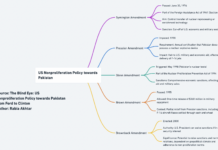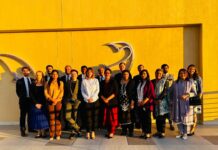Bilal Ghazanfar
Recent trends indicate that the nature and conduct of war are transmuting as emerging technologies (ETs) have revolutionized military strategies and tactics. In the years to come, technological determinism will be a crucial factor for any country to stay ahead of the curve. The Barcelona Centre for International Affairs’ (CIDOB) report identifies seven priority areas: quantum computing, microsatellites, Artificial Intelligence/Machine Learning (AI/MI), advanced robotics, electric batteries, biotechnologies, and advanced radiofrequency, which will determine the new centers of power in the 21st century. From a strategic perspective, the ability to build, dominate, and manage ETs under an overarching, clear strategic vision will be an enabling factor for states to exert control and influence on issues vital to their national interests.
All of these developments are relevant to Pakistan for a number of reasons. First, Pakistan’s strategic calculus confronts old and emerging challenges that generate compounding crises when coupled together. Considering its threat spectrum, Pakistan cannot remain indecisive about ETs. Pakistan’s counterterrorism (CT) and Countering Violent Extremism (CVE) strategies will come under stress in a few years if the country fails to integrate these technologies (AI, ML, and quantum commuting) in its security frameworks. According to Dr. Christina Schori Liang of the Geneva Centre for Security Studies (GCSP), terrorists are embracing ETs to harness their powers in both the physical and psychological domains. The World Economic Forum’s Global Risk Report 2023 identifies misinformation, disinformation, and mal-information as major non-traditional security threats to Pakistan, which will create new societal and political fault lines.
Second, the U.S.-India tech partnership has multilevel implications for Pakistan. ETs will provide strategic spaces for India to reevaluate its force postures and nuclear doctrines, which will have dangerous repercussions for strategic stability in South Asia. Key elements of AI and ML will support decision-making and enhance operational efficiency and situational awareness for the Indian armed forces. Dr. Adil Sultan, an expert on strategic affairs, notes that ETs will incentivize states to engage in limited conflicts without fearing the risks of a major backlash. These technologies will have a profound impact on the entire spectrum of strategic affairs as they will provide asymmetrical advantages to countries that possess them. In South Asia’s strategic environment, they will be game changers.
Lastly, Pakistan confronts challenges in social, cultural, economic, and environmental domains. ETs play a role of double-edged sword in issues concerning human development and non-traditional security. Therefore, Pakistan can harness these technologies for their inclusive application to ensure inclusive prosperity. However, unregulated and ungoverned application of ETs raises ethical issues. Considering Pakistan’s predicaments, the wide-ranging applications of these technologies necessitates a holistic and futuristic approach. However, Pakistan lacks the capacity for the induction and indigenization of these technologies for civil and military uses. That being said, the external environment could help it navigate this problem.
China and the U.S. are competing in inducting ETs, positioning to take the next giant leap in the 4th Industrial Revolution. According to the CIDOB report, both countries are leading in high-impact scientific publications in these spheres. However, China’s technological landscape has grown rapidly to challenge America’s technological superiority. China’s strategy is focused on innovation rather than imitation, enabling the country to take giant strides in a few areas. China is also using these technologies in the civilian domain as well.
In the 21st century, Pakistan and China’s Comprehensive Strategic Partnership has matured and is by no means transactional in nature. Pakistan remains a reliable partner and a friend of China in a volatile geostrategic environment where the biggest threat to Chinese interest is disruption in supply chains linked to its economy. Apart from a few areas that remained the soft underbelly, the relationship between both states is strengthened by shared views on global security and strategic architectures. This cooperation is centered on ‘meaningful engagement’ to counter treacherous regional and global challenges. China’s willingness to sell the 5th generation aircraft, Shenyang FC-31 Gyrfalcon, reflects its role as a dependable partner in the security and defense spheres. To catch up in the field of ETs, Pakistan needs to take advantage of China’s expertise in them. Also, Pakistani policymakers must take steps to enhance technological cooperation in both civil and military spheres with China.
Apart from all this, Pakistan needs to develop its indigenous capacities and capabilities. The National Aerospace Science & Technology Park (NASTP) stands as a success story for Pakistan, playing a key role in fostering the country’s development of ETs. Through organizations like the NASTP Institute of Emerging Systems and Technologies (NIEST) and technoparks like Silicon 1, NASTP creates an ecosystem conducive to growth in ETs.
In sum, it is reasonable to argue that Pakistan’s future hinges on the optimal integration of ETs. In other words, achieving sustainable growth and navigating future conflicts will depend upon Pakistan’s application of ETs in various sectors. In this regard, Artificial Intelligence, cybersecurity, and aerospace hold immense potential, and by harnessing them, Pakistan can propel itself toward enhanced national security, economic growth, and scientific advancement.
Dr. Bilal Ghazanfar is Associate Senior Researcher, Centre for Aerospace and Security Studies (CASS), Lahore, Pakistan.
The views expressed in the article are the author’s own and do not necessarily reflect those of Pakistan Politico.

















